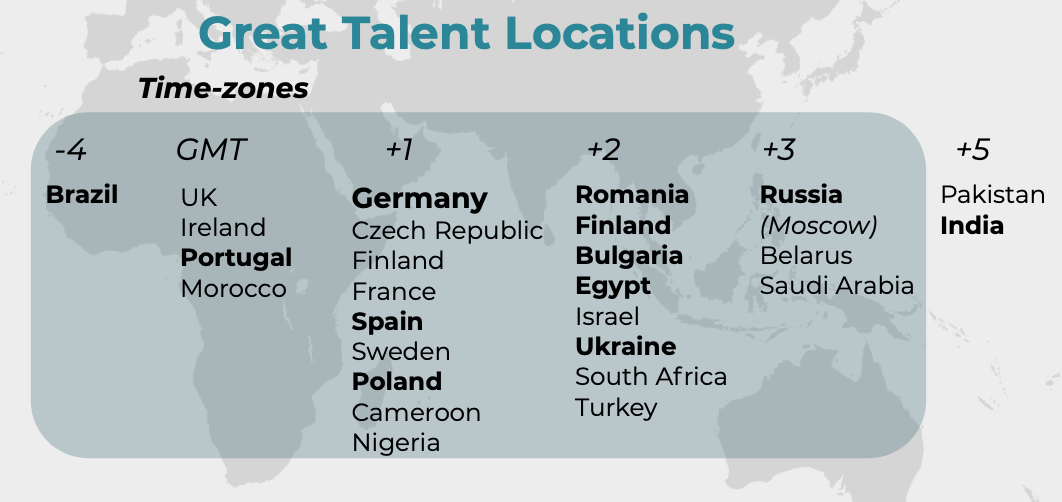
During the past year, millions of people have been working from home. What at the beginning seemed to be a short-term solution, has been getting traction and now, one thing is for sure: whether it is working from home or elsewhere off-site, remote working is here to stay.
But what does this mean for companies? How can you build on what you have and make the most of this working approach? Rest assured that the right remote working policy will be essential to your success.
The importance of a remote work policy
Before the pandemic, many companies were dipping their toe into the waters of remote work, but when the pandemic hit, they were all thrown into the deep end. And that was when the lack of a remote work policy became a significant problem.
However, as one says: “The human is the only animal that trips twice over the same stone”.
The majority of companies make the mistake of only linking their resources to support remote work with the success of this approach, forgetting the importance of the implementation of a remote work policy. There are many problems that might arise from the lack of a remote policy: confusion, lack of productivity and more.
Why should a company build a remote work policy?
Having a remote work policy in place means more structure and guidance for your employees.
Within a remote setting, it is of even greater importance to avoid disagreements and communication issues. Having rules in place always brings more structure and clarity.
Having said that, it is important to understand that having a remote work policy in place is not so much about laying down the law but more about giving more independence and autonomy to your employees, eventually driving productivity and your company’s success.
Must-have remote work policies
Even though remote policies differ from company to company, there are some common areas that should always be addressed.
Cybersecurity
When working remotely, different risks in terms of cybersecurity can become an essential problem for your network. Remote workers are often the target of cyber attacks.
Some reasons are for example the use of personal devices and WIFI connections which are not as protective as corporate devices and networks but also the fact that cybercriminals are well aware that many businesses did not have the right security protocols in place when the pandemic hit and therefore are more vulnerable now than ever.
Altogether it is a matter of unsecured technology systems, overworked IT staff and confused employees who are new to working in a remote setting. Many of these issues can be avoided through a remote working policy.
Equipment
Work equipment is another aspect that should be looked at carefully as well as included in the company’s remote policy.
For instance, companies should provide the technological devices needed to facilitate their job.
Further questions that should be answered in a company’s remote work policy are who provides the equipment, which sets it up and also, very importantly who is responsible for it. Guidelines and rules about how to use the equipment and what to do if something goes wrong are also essential.
Location
After this year, most of us already know what jobs can perfectly be done remotely, which ones can be done remotely but in a limited way and which ones are fixed to a specific location.
Looking into the future, flexibility will increase and we will not be working remotely all the time since this would rather be counterproductive depending on the task. Every company needs to find their sweet spot regarding productivity boost within a remote setting, which often occurs when your employees work off-site 60% to 80% of the time.
It is also worth establishing where people will be able to work. Shall remote work only happen from home? Or are public spaces also allowed?
In general, existing remote policies will need to shift from asking “When and how are employees to work outside of the office space?” to “When and how are employees to work from the office?”.
Working hours
One of the greatest perks of working remotely is the flexibility around time.
Working a 9-5 is not the norm anymore; employees are able to work hours in which they are most productive and boost flexibility.
This is also a great benefit in terms of allowing your employees to better balance other responsibilities as would be child-care along with their full-time job.
However, this is not so easy to implement in processes and tasks and if we start to think about different time zones, it only gets more and more complicated.
To begin with, we at WorkMotion would not recommend having more than 4 hours of time difference across time zones in order to keep the collaboration within the company efficient.
Further, it is not only a matter of your employees not being available when they are needed, but also the opposite with your employees answering emails at 10 PM on a Saturday which can take a toll on their mental health.
Clear guidance on working hours in a remote work policy is imperative to tackle all these issues.
Communication
The right way of communication is an aspect that can cause headaches even in an office setting.
The lack of proper communication can lead to a variety of problems, from poor performance and productivity to mental health issues such as isolation, depression and anxiety.
That is why including communication guidelines in your remote work policy is a must. One has to make sure the information flow happens in both ways and not only top-down.
It can be useful to establish fixed channels of communication as well as tools that facilitate information exchange. Guidelines on how to conduct productive meetings and joint working sessions are also an example of how to improve communication in a remote-working company.
Keep the eyes on the ball with WorkMotion
It is easy to get lost in all the different parts of your company that would need more guidance and regulation. However, it helps to simply focus on what you want to get out of a remote working environment. Is it cost reduction? Or is it talent access? Or maybe something else?
Make sure to adapt your policy and equip it with guidance, rules and resources for your employees and yourself.
And if you need some extra help in order to not only get remote right but also to thrive while doing so, WorkMotion has your back.
We can help you reach the full potential of a remote work environment and figure out how to reach your HR-goals best, attracting, managing and keeping employees all around the world in a compliant and easy way.
Sound good? Contact us!
Latest articles

Overcoming talent shortage in Germany with global hiring

10 awesome remote work rituals you should implement in 2024


